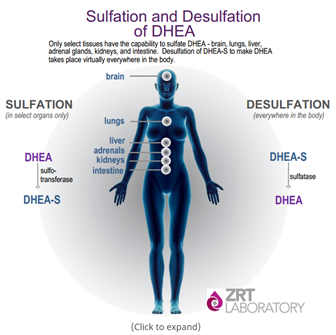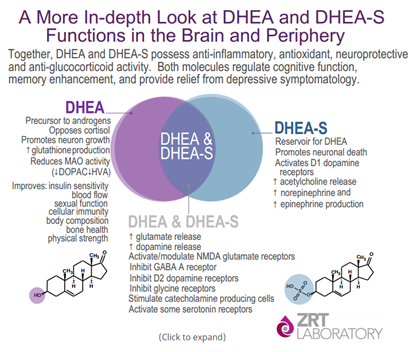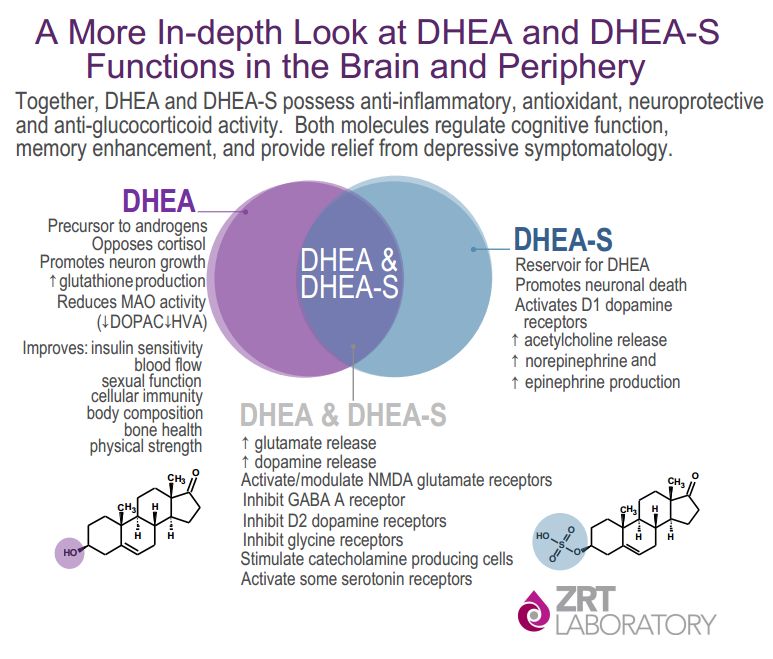
Everything we do, feel, think – it all starts with the brain. A balanced, healthy brain helps lay the essential foundation for optimal wellbeing. A small but significant aspect of brain health is regulated by a specific class of steroid molecules called neurosteroids.
That the brain is a steroidogenic organ is widely accepted, and neurosteroids are woven into its very fabric. In fact, the term “neurosteroid” refers to cholesterol-derived steroid compounds that play critical roles in the nervous system - its development, maintenance and survival. “Neurosteroids: of the nervous system, by the nervous system, for the nervous system” as Baulieu said a decade and a half following the remarkable discovery of the very first neurosteroid - DHEA-S [1] [2].
As the levels of DHEA and DHEA-S decline with age, the brain loses their protective properties and becomes more sensitive to the ravages of neurological decline. This blog is going to focus on DHEA and its sulfated form DHEA-S and their relevance to brain health.
Terms used commonly throughout this blog post:DHEA = dehydroepiandrosterone
DHEA-S = dehydroepiandrosterone sulfate
DHEA(S) = total pool of DHEA and DHEA-S in the body |
Dehydroepiandrosterone (DHEA) is plentiful in the human body - together with its sulfated form (DHEA-S), DHEA comprises the most abundant form of steroid hormones [3]. In fact, the average concentration of DHEA-S in the bloodstream is about 10,000 times higher than the most potent estrogen - estradiol (typical estradiol levels around 0.1 ng/mL vs 1000 ng/mL for DHEA-S). Derived from cholesterol, DHEA is produced by the adrenal glands, brain, ovaries and testes, and is a precursor for the major sex steroids (estrogen, progesterone, and testosterone). Sometimes called the "anti-aging hormone" or even the "fountain of youth," it is no wonder that supplementation with DHEA to its mid-normal physiologically youthful levels appears to engender a sense of wellbeing and reestablish that "zest for life"[4].
DHEA-S levels peak around mid-twenties and gradually decrease to around 20% by age 70. Unfortunately, once DHEA levels begin to wind down, there are no feedback mechanisms to help restore it. As DHEA and downstream metabolites decrease, the brain loses the protective effects of sex steroids and becomes increasingly vulnerable to neurotoxic effects of cortisol and other potentially damaging factors. With declining DHEA-S levels, cortisol levels remain constant, resulting in an increased cortisol/DHEA-S ratio. The unbalanced relationship between the too high cortisol and not enough DHEA-S is serious enough that it can create potentially harmful conditions for the hippocampus and contribute to neurodegenerative disease pathology. Specifically, brain imaging studies show that the decreased DHEA-S levels are closely associated with decreased hippocampal function in Alzheimer’s disease [5].
This is why DHEA is commonly prescribed to female and male patients presenting with low androgen symptoms in combination with low circulating DHEA-S and/or low testosterone levels. DHEA replacement therapy can certainly impede the ravages of aging - adequate levels help ramp up the levels of downstream sex steroids, enhance the ability to adapt to stress, increase libido, improve the body fat ratio, and boost the immune system [6]. However, it is important to monitor the levels of the sex steroid hormones as well as DHEA-S during supplementation – just like with too little DHEA, too much DHEA (and/or DHEA-S) can have its own set of distressing symptoms.
|
Low Androgen Symptoms
|
High Androgen Symptoms
|
Why Measure DHEA-S?
At ZRT we test for DHEA-S, the sulfated form of DHEA. Providers often call with questions regarding the difference between DHEA and DHEA-S. The difference in structure of the two molecules is the presence of a sulfate group – DHEA-S is the sulfated form of DHEA. Approximately 98% of circulating DHEA in the bloodstream is the sulfated form (DHEA-S). DHEA-S binds more strongly to albumin, its carrier protein, than DHEA, thus contributing to the slower metabolic clearance from circulation [7]. In addition to the longer biological half-life, DHEA-S does not exhibit a strong diurnal rhythm as seen with cortisol and DHEA, nor does it vary from day to day [8]. Additionally, the levels of DHEA-S run in parallel to those of DHEA, and correlate very closely with clinical symptoms of androgen deficiency and excess.
Consequently, DHEA-S represents a more stable index of adrenocortical activity and stress accumulated over time, whereas DHEA may better reflect the response to acute stressors. So when we measure DHEA-S, we gain an understanding of the body’s systemic biological reservoir of DHEA. All of the above reasons make DHEA-S the ideal molecular testing candidate.
When it comes to function, both DHEA and DHEA-S molecules have profound physiological effects on the body. One particular role I would like to focus on may often get overlooked – the actions of both DHEA and DHEA-S in the nervous system.
DHEA-S & the Central Nervous System
For many years, DHEA has been regarded as inactive and merely a forerunner of androgens and estrogens in the periphery – this observation was based on the inability to detect classical nuclear DHEA receptors observed those for other steroid hormones (estrogens – ER, progestogens – PR, androgens – AR, glucocorticoids – GR, mineralocorticoids – MR). However, more recent evidence sheds the light on DHEA not just as a pro-hormone, but rather an active hormone in its own right. Nowadays, not only DHEA, but DHEA-S as well are recognized for regulating a myriad of biological processes, with a remarkable tropism especially for the central nervous system. DHEA and DHEA-S play important roles in the development, maintenance and survival of the central nervous system. Both hormones modulate neurotransmitter synthesis and release, immunity and inflammation, endothelial and cognitive function, and neurogenesis and neuronal survival.
Independent of age, serum levels of DHEA-S appear to be positively correlated with healthier psychological profiles - executive function, working memory, attention, concentration, enjoyment of leisure activities and overall stress-buffering effect [3]. Imbalance in the DHEA pool tends to be associated with distress and psychopathology, such as depression, anxiety, bipolar disorder, eating disorders, PTSD and perceived stress [9] [10] [11]. Specifically, DHEA-S levels are inversely correlated with hyperactivity, suggesting a possible protective role in the etiology of ADHD [12]. Low DHEA-S levels have been reported in young patients with anorexia nervosa. Moreover, lower DHEA levels go hand-in-hand with the degree in severity of depression [13]. And on the flip-side, too-high levels have been detected in patients with mania [14]. Elevated DHEA-S and reduced cortisol have also been reported in patients with PTSD [3].
Mechanisms of Action
"Typical" steroid molecules (such as estradiol, testosterone and progesterone) modulate their effects by entering target cells, binding to their receptors and initiating cascades that either activate or inhibit the expression of various downstream proteins (some non-genomic mechanisms have been described as well by modulating fast-acting membrane receptors). The fascinating thing about neurosteroids is that they work in a slightly different fashion.
There is considerable ambiguity regarding whether a DHEA receptor does, in fact, exist. What is known, however, is that DHEA and DHEA-S act directly on neurotransmitter systems to regulate synaptic transmission. Specifically, these neurosteroids modulate neuronal excitability by directly interacting with neurotransmitter systems, such as dopamine, serotonin, glutamate, and GABA amongst others [15].
DHEA and DHEA-S bind to and both activate and modulate the NMDA glutamate receptor, potentiate dopamine and serotonin signaling, and inhibit the GABA A receptor activity. Crudely, all of this means that DHEA-S helps keep that fire going – that the excitatory neurons are firing properly, but also that the fire is burning "just right" and is not out of control.
Same But Different
Here comes the really cool part – there are many functions that DHEA and DHEA-S perform in similar ways; however, they have their own distinct mechanisms as well [15]. For example, both molecules can stimulate dopamine release, a neurotransmitter well-known for being the "pleasure center" of the brain. However, the paths to raise dopamine are different. DHEA-S uses genomic, slow, long-lasting mechanisms to do so by upregulating tyrosine hydroxylase levels, the enzyme responsible for dopamine production. DHEA, on the other hand, signals to increase dopamine levels in rapid, intense, short-lived bursts. For a more complete story on what neurotransmitter processes DHEA and DHEA-S regulate together and separately, please see the figure above.
Treatment Considerations
While DHEA is available over the counter in health food stores, it is best used under medical supervision with the goal of restoring low levels to the physiological range. When treating a patient with low androgen symptoms and low DHEA-S levels, it is important to consider the route of hormone administration (e.g., most common routes are oral, sublingual, topical, and vaginal) and testing options for measuring DHEA or DHEA-S (saliva, blood spot, serum, or urine).
Topical DHEA
If personal biochemistry does not allow for DHEA-S to be readily converted to DHEA, the topical route may be preferred. |
When administered topically, DHEA restores skin elasticity, relieves symptoms of vaginal dryness and atrophy (with vaginal application), and generally improves many low-androgen symptoms [16]. The caveat with topical DHEA administration is that it does not undergo first-pass metabolism through the liver (no liver passage - no sulfation), so although a subsequent increase in salivary and blood spot DHEA is observed, DHEA-S levels remain unchanged. The levels of the hormone in saliva represent the "free" hormone fraction, available for tissue uptake. Animal studies show that with topical DHEA treatment, the unsulfated DHEA crosses into the brain and gives rise to DHEA-S right on site. With topical DHEA supplementation, the practitioner has to rely on monitoring the patient’s progress with improving symptomatology, which may be a challenge in and of itself. If low androgen symptoms persist with topical DHEA treatment, switching to oral dosing may prove to be a more effective strategy. It is important to know that topical DHEA therapy will raise serum and salivary DHEA levels, but have little effect on DHEA-S levels in these body fluids.
The advantage of topical DHEA administration, however, is for those patients with known sulfatase SNPs. If personal biochemistry does not allow for DHEA-S to be readily converted to DHEA, the topical route may be preferred.
Oral DHEA
With oral DHEA administration we see a substantial spike in DHEA-S levels in all commonly tested body fluids (saliva, blood spot, serum, or urine) (undergoes first-pass metabolism and gets sulfated), and a marked improvement in symptoms as well. However, once DHEA becomes sulfated to DHEA-S, it is unable to cross the blood-brain barrier (DHEA is non-polar and crosses the blood-brain barrier easily, whereas DHEA-S is polar and does not cross into the brain from periphery). It is plausible to assume that DHEA-S that arises from first-pass metabolism after oral DHEA administration behaves in a similar manner to endogenous DHEA-S and contributes to the body’s biological reservoir of DHEA, readily converting to DHEA when the need arises.
Troche DHEA
How you take DHEA definitely impacts how much gets into the brain and how fast. For example, troche (sublingual) DHEA goes directly into the bloodstream (measured in serum) and because it’s not sulfated, it crosses directly into the brain and other tissues. Some patients are particularly sensitive even to small amounts (5 mg) of DHEA administered this way - with agitation being a common side effect. In this case, taking DHEA orally could have a more gentle uplifting sensation of wellbeing.
Clinical Utility of Neurosteroids
Since the discovery of neurosteroids in the early 80s, significant efforts have been poured into studying the role they play in brain-related disorders. Gleaning insight into the mechanisms that underlie neurosteroid involvement in mood pathologies may extend their clinical utility to treatment of mood and anxiety disorders, alcoholism, sleep disorders, chronic pain, traumatic brain injury, neurodegenerative disorders and many others [17]. Specifically for DHEA, it has been exciting to see the evolution of knowledge regarding this molecule’s behavior in the brain. Overall, DHEA is well-poised in clinical development for its therapeutic potential in helping the aging brain retain its regenerative capacity.
Related Content
- Provider Overview: NeuroEndocrine Testing
- Provider Data Sheet: Neurotransmitters Testing
- Blog: Lithium's Billion Year Journey - A Cinderella Story for Brain Health
References
[1] Baulieu EE, Robel P: Dehydroepiandrosterone (DHEA) and dehydroepiandrosterone sulfate (DHEAS) as neuroactive neurosteroids. Proc Natl Acad Sci U S A 1998;95:4089-4091.
[2] Baulieu EE: Neurosteroids: of the nervous system, by the nervous system, for the nervous system. Recent Prog Horm Res 1997;52:1-32.
[3] Maninger N, Wolkowitz OM, Reus VI, Epel ES, Mellon SH: Neurobiological and neuropsychiatric effects of dehydroepiandrosterone (DHEA) and DHEA sulfate (DHEAS). Front Neuroendocrinol 2009;30:65-91.
[4] Muskin PR: Complementary and Alternative Medicine and Psychiatry. Washington, DC, American Psychiatric Press, Inc., 2005.
[5] Murialdo G, Nobili F, Rollero A, Gianelli MV, Copello F, Rodriguez G, Polleri A: Hippocampal perfusion and pituitary-adrenal axis in Alzheimer's disease. Neuropsychobiology 2000;42:51-57.
[6] Lee JR, Zava DT, Hopkins V: What Your Doctor May Not Tell You About Breast Cancer. New York, Hachette Book Group, 2003.
[7] Kamin HS, Kertes DA: Cortisol and DHEA in Development and Psychopathology. Horm Behav 2016.
[8] Starka L, Duskova M, Hill M: Dehydroepiandrosterone: a neuroactive steroid. J Steroid Biochem Mol Biol 2015;145:254-260.
[9] Sripada RK, Marx CE, King AP, Rajaram N, Garfinkel SN, Abelson JL, Liberzon I: DHEA enhances emotion regulation neurocircuits and modulates memory for emotional stimuli. Neuropsychopharmacology 2013;38:1798-1807.
[10] Buoli M, Caldiroli A, Cumerlato MC, Serati M, de NJ, Altamura AC: Biological aspects and candidate biomarkers for psychotic bipolar disorder: A systematic review. Psychiatry Clin Neurosci 2016;70:227-244.
[11] Strous RD, Maayan R, Weizman A: The relevance of neurosteroids to clinical psychiatry: from the laboratory to the bedside. Eur Neuropsychopharmacol 2006;16:155-169.
[12] Strous RD, Spivak B, Yoran-Hegesh R, Maayan R, Averbuch E, Kotler M, Mester R, Weizman A: Analysis of neurosteroid levels in attention deficit hyperactivity disorder. Int J Neuropsychopharmacol 2001;4:259-264.
[13] Michael A, Jenaway A, Paykel ES, Herbert J: Altered salivary dehydroepiandrosterone levels in major depression in adults. Biol Psychiatry 2000;48:989-995.
[14] Dubrovsky BO: Steroids, neuroactive steroids and neurosteroids in psychopathology. Prog Neuropsychopharmacol Biol Psychiatry 2005;29:169-192.
[15] Perez-Neri I, Montes S, Ojeda-Lopez C, Ramirez-Bermudez J, Rios C: Modulation of neurotransmitter systems by dehydroepiandrosterone and dehydroepiandrosterone sulfate: mechanism of action and relevance to psychiatric disorders. Prog Neuropsychopharmacol Biol Psychiatry 2008;32:1118-1130.
[16] Labrie F, Belanger A, Belanger P, Berube R, Martel C, Cusan L, Gomez J, Candas B, Chaussade V, Castiel I, Deloche C, Leclaire J: Metabolism of DHEA in postmenopausal women following percutaneous administration. J Steroid Biochem Mol Biol 2007;103:178-188.
[17] Zorumski CF, Paul SM, Izumi Y, Covey DF, Mennerick S: Neurosteroids, stress and depression: potential therapeutic opportunities. Neurosci Biobehav Rev 2013;37:109-122.




